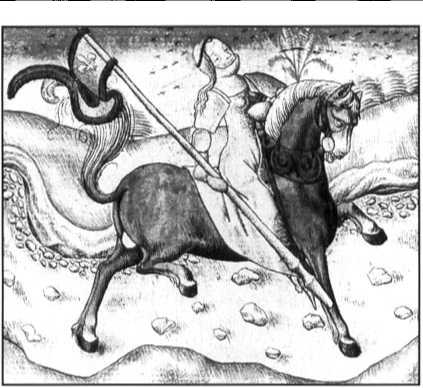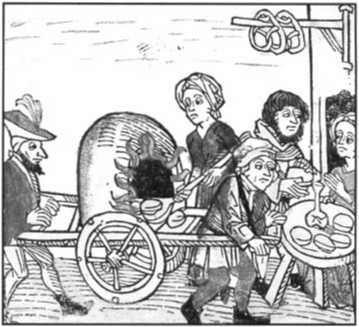Iuch of what is known about Joan of Arc comes from her testimony at her trial for heresy in 1431. She was bom in the village of Domremy in eastern France. Her father was a well-to-do peasant, but she was not literate. Her early life included games, sewing, spinning, and prayers.
But this tranquil life was periodically interrupted by incursions of Burgundians who looted the countryside. During these attacks, the local people went to fortified cities for safety. According to her trial transcript, Joan began having visions that urged her to make an appeal to King Charles and rescue France from the Burgundians and the English: “Two or three times a week the voice said she must leave and go into France. . . she must raise the siege then being made of the city of Orleans.” She persuaded one of the king’s captains that she was serious, and he gave her a suit of

Joan of Arc favored armor and male attire, but medieval artists found this so repulsive that they represented her in female dress.
Armor and an escort to Charles. She convinced him to give her troops to attack the city’s besiegers. She herself did not fight, but she provided encouragement and the siege was relieved.
After this success in warfare, she encouraged Charles to go to Rheims and have himself properly crowned king as the French kings before him had done. The French gained new resolve from this move and continued to fight against the En
Glish and Burgundians. Joan was captured by the Burgundians and the English had her put on trial for witchcraft and heresy in a Burgundian church court. After a vigorous self-defense she finally confessed but took back her confession. She was burned in the public square in 1431. Charles did nothing to defend or rescue her. Although she immediately became the symbol of resistance for France, she was not made a saint until 1923.
Claimed the throne by virtue of the third son ofEdward III. The Lancastrians also maintained they had a right to the crown because they descended from the fourth son of Edward III and their line included Henry V and his son Henry VI. (Popular custom assigned the red rose to this party.) The wars were fought largely between contenders for the throne and their noble adherents. During their course, such notable characters as the Yorkist Richard III emerged as historical figures. His claim to the throne
Was encumbered by two young nephews who were in direct succession before him. When they disappeared into'the Tower of London, he was accused of having them murdered. Finally, in 1485 Henry Tudor defeated Richard at the battle of Bosworth Field. He became Henry VII, the founder of the Tudor dynasty. Richard fought gallantly to the end and died on the battlefield. In his play Richard III, Shakespeare was certainly wrong in portraying him as a coward who in his final moments called out, “A horse, a horse. My kingdom for a horse.”
Throughout this period the Church provided little political or spiritual leadership. The popes continued to live in Avignon, but the critics of the papacy were becoming more and more insistent. Two women who eventually became saints, Brigitte of Sweden and Catherine of Siena, urged the popes to reform and return to Rome. Political theorists at universities were arguing that the Church should be governed by a council composed of laymen as well as clergy. They also maintained that the papacy should not be the dominant power in the religion or politics of Europe.
Even more serious were the attacks of John Wycliffe (c. 1330-1384), an ordained priest and professor at Oxford University. Increasingly, he argued that the papacy was cormpt and deviated from the early Church. He placed his behefin the authority of the Bible rather than the later pronouncements of popes, and he favored direct prayer rather than reliance on priests to intervene between Christ and Christians. His theology was so radical that he quickly came to be regarded as a heretic. Because he felt that the clergy should experience the poverty of the early apostles, he recommended the confiscation of church property. This position won favor at the English royal court, and he was protected from prosecution.
Wyclifie soon won followers in England, but more important were the students who brought his ideas from Oxford University to Prague University. In Prague Jan Hus, a young theologian, became attracted to WycHffe’s ideas and began to make them popular with the laity as well as the university community. His movement became tied up in poHtics and the revolt of the Bohemians (Czechs) against their German rulers.
While the theological attacks and popular lampoons against the papacy continued, the papacy became more and more mired in corruption. In 1378 Pope Gregory XI returned to Rome at the urging of Catherine of Siena, but he died that same year. Pressured by a Roman mob that broke into the voting chamber, the College of Cardinals selected an Italian pope. With the encouragement of the French king, the cardinals returned to Avignon and elected a French pope. Neither pope would abdicate, and the Great Schism began with a pope in Rome and a pope in Avignon. When these popes died, their respective Colleges of Cardinals selected another pope in each of their places.
Needless to say, the scandal of the Great Schism was immense. St. Peter could hardly have two voices on earth offering competing jurisdictions. The laity were concerned that since the schism no one had gone to heaven and baptisms were no longer removing original sin. With resources spread between the two popes, papal fundraising became even more voracious.
Finally, in 1409 a council was held in Pisa to resolve the schism. The council was intended to depose the two popes and elect a new one, but neither pope would abdicate. The third pope claimed that he was the only legitimate one because the Council of Pisa had elected him. With three popes and three colleges of cardinals, it was apparent that the Church could not reform itself Emperor Sigismund of Germany called a council at Constance representing laity and clergy from all over Europe to resolve the schism, reform the Church, and get rid of heresy.
The Council of Constance managed to depose all three popes and elect an Italian pope who was acceptable to Rome and a newly formed College of Cardinals. The Council next turned to the question ofjan Hus. He was given safe conduct to Constance in order to defend his views. Thinking that he would receive a fair hearing because the Council was dedicated to reform, he came of his free wfil. Emperor Sigismund, however, had little sympathy for him because he had been at the heart of the Bohemian revolt. Hus was tried as a heretic and burned. Even Wycliffe was condemned, and his bones were dug up and burned. Having solved the two easier problems, the Council disbanded without taking up the larger problem of church reform.
One of the distinctive features of the earlier Church had been that new monastic movements took the lead in reforming the

Medieval urban residents often did not have a kitchen in their quarters and relied on the equivalent of “fast food. ” Two men moved an oven on a cart around the city and a woman made fresh bread and meat pies for customers. Other women sold prepared goods outside of shops, Tire shop sign shows that pretzels were available and the table indicates the availability of beer or wine (in the flask) and loaves of bread.
Bom in 1347,
Catherine of Siena was the 24th child of a wool-dyer and his wife. Living just down the hiU from a Dominican church, Catherine resisted aU her parents’ efforts to persuade her to lead a normal life and marry. Early on she instead embraced self-sacrifice in order to show her devotion to God. She scalded herself in hot baths, developed skin problems, and withdrew from her family. She fasted and rejected meat entirely. She was, perhaps, anorexic, because her biographer reported seeing her stuff twigs down her throat to bring up food. He wrote: “I myself saw it happen, not once, but again and
Again, that her emaciated body would be reduced to the last extremity, unable to take anything to restore its forces but a drink of cold water. . . and then suddenly she would seize... an opportunity of taking on some work for the honor of God’s name or the good of souls, and like a flash, without the help of any other restorative [food] . . . all her forces would revive.” She said in her letters that she was afflicted by God so that she would understand suffering and be purged of her gluttony.
Catherine kept a close association with the Dominicans aU her life but did not become a nun.
She preferred to go out into the world and work
With the poor and sick. On one occasion she angered her father by giving away his best wine, but the cask was miraculously refilled. Catherine was educated and wrote extensively in Italian. Her works include 400 letters and a dialogue about her mystical experiences. In the dialogue God provided answers to a Christian soul about questions regarding reform of the Church and salvation of souls. In 1376 she went to Avignon and helped persuade the pope to return to Rome. Unfortunately, his return led to the Great Schism, which was in progress when in 1380 Catherine died from a stroke at the age of 33.




 World History
World History









